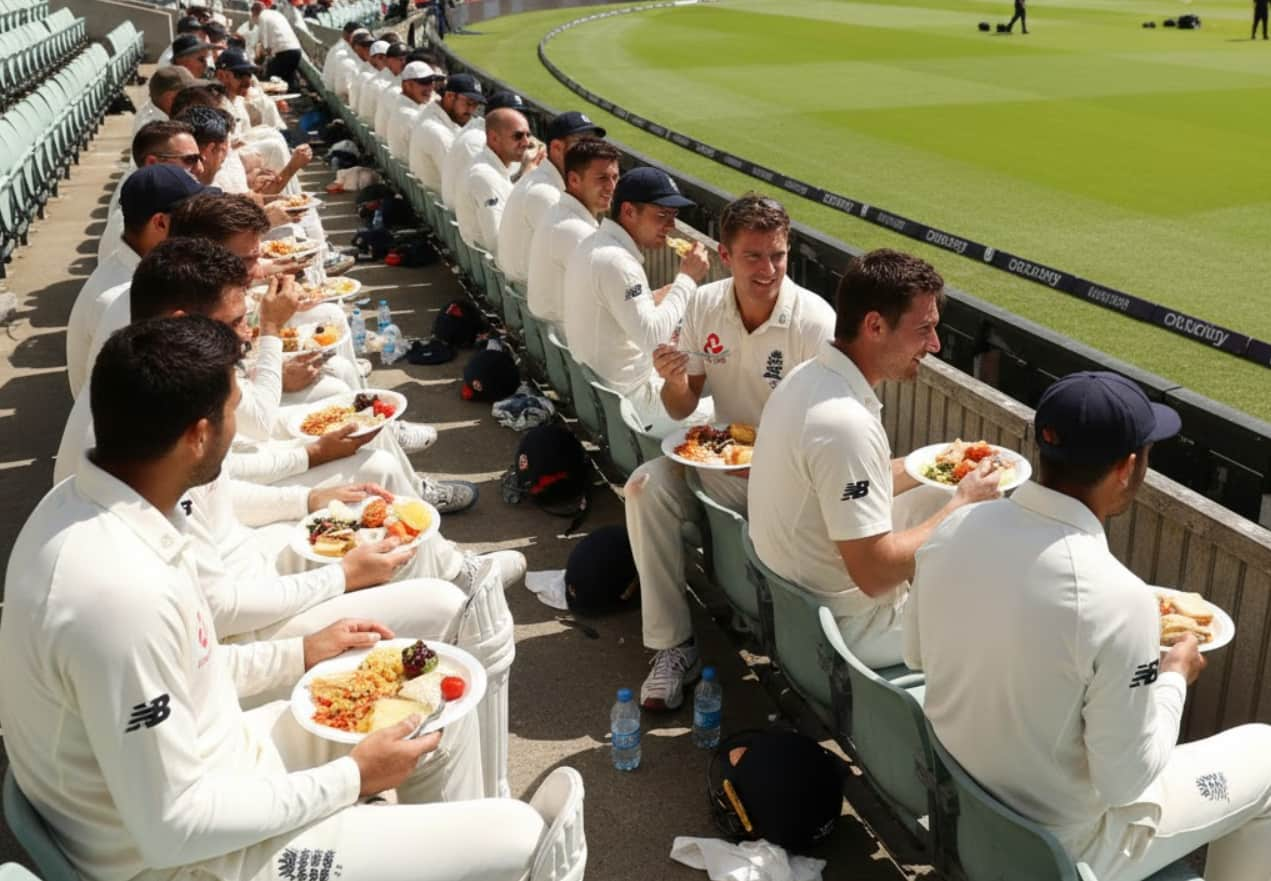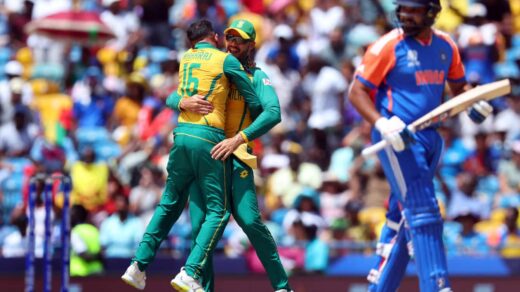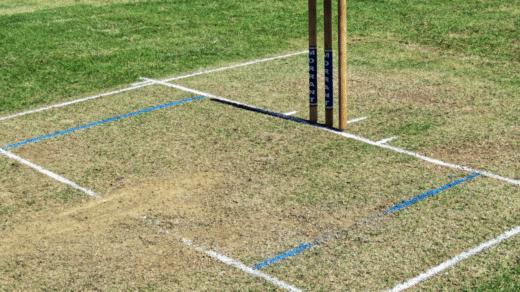Test cricket is the longest format of the game, lasting up to five days with each day divided into three sessions.
Unlike T20S or ODIs that finish in hours, Test matches require immense stamina, concentration, and strategic planning.
One crucial element that shapes Test cricket is the lunch break — a 40-minute pause that happens after the first session of play.
This break isn’t just about food; it’s a strategic reset button that can change match momentum, allow players to recover, and give captains time to plan their next moves.
Understanding the lunch break time in Test cricket helps fans appreciate the game’s rhythm and strategy.
From official rules to tactical implications, the lunch interval plays a bigger role than most people realize.
Lunch Break Time in Test Cricket

Let’s explore everything about how long is lunch in test cricket, the rules governing it, and how it impacts the beautiful game.
Also Check: Virat Kohli’s Double Centuries in Test Cricket
Official Rules: Lunch Break Time in Test Cricket
The lunch break in Test cricket is governed by the MCC Laws of Cricket Rules, which outline intervals and their timings.
Here’s what the official rules say:
Standard Lunch Timing:
| Condition | Standard Scenario |
|---|---|
| Session Start Time | 11:00 AM (local time) |
| Lunch Break Time | Around 1:00 PM |
| Duration of Lunch | 40 minutes |
| Governing Rule | MCC Law 12.2 |
| Over Rate Flexibility | Lunch may shift if 30 overs not completed |
| Resumption Time | 1:40 PM (approximately) |
How It Works:
In a typical Test match, play begins at 11:00 AM local time. The first session continues for approximately two hours, during which teams aim to complete around 30 overs. After this, the lunch break is taken at roughly 1:00 PM.
The lunch interval lasts exactly 40 minutes, giving players enough time to eat, rest, and prepare for the afternoon session. Play resumes at 1:40 PM for the second session.
Important Rule Details:
The umpires have the final authority on when to take lunch. They consider:
- Number of overs bowled in the session
- Match the situation and weather conditions
- Whether an over is in progress
- Agreement between both teams
Flexibility in Timing:
The lunch break time in Test cricket isn’t always fixed at 1:00 PM. If the first session is delayed due to rain or bad light, lunch might be taken later, but still after the scheduled number of overs (usually 30).
For example, if the play starts at 12:00 PM instead of 11:00 AM due to morning rain, lunch would typically be around 2:00 PM, maintaining the two-hour session duration.
Variations: When Weather or Delays Affect Lunch
Test cricket is played outdoors, making it vulnerable to weather interruptions. Rain, bad light, or other delays can significantly change when lunch is taken. Let’s understand how these variations work:
When Rain Delays the Start:
- If play starts late, lunch may still occur at the usual clock time (1:00 PM), regardless of when play began
- Alternatively, it could be taken after completing a set number of overs
- The match referee and umpires decide based on the playing conditions and the remaining time
When Rain Comes Close to Lunch:
- If rain stops play at 12:45 PM (15 minutes before scheduled lunch), umpires can advance the break
- This prevents wasting time with a short playing period followed immediately by lunch
- Players go for early lunch and return when conditions improve
Mid-Over Considerations:
- Lunch is never taken mid-over unless necessary
- If the scheduled lunch time arrives during an over, play continues until the over is completed
- This maintains fairness and doesn’t give an advantage to either batting or bowling side
Key Points to Remember:
- What time is lunch at the cricket today depends on the match location, start time, and local conditions
- Different countries have different traditional start times, affecting lunch timing
- Day-night Tests have completely different meal break schedules
- Umpires communicate any timing changes to both teams well in advance
Example Scenario:
Imagine a Test match where morning rain delays the start until 12:30 PM. The umpires might decide:
- Play until 2:30 PM, then take lunch (maintaining the 2-hour session)
- Or, take lunch at the regular 1:00 PM clock time, giving only 30 minutes of play before lunch
The decision depends on the forecast, light conditions, and the match situation.
Lunch Break Impact on Players and Strategy
The lunch interval isn’t just a break — it’s a tactical element that can change the entire complexion of a Test match. Here’s how it impacts different stakeholders:
For Batsmen:
Positive Impact:
- Mental refreshment after concentrating for 2+ hours
- Physical recovery from standing and batting
- Opportunity to discuss strategies with coaches
- Can reset after a difficult first session
Negative Impact:
- Breaking batting rhythm when well-set at the crease
- Losing momentum if scoring freely before lunch
- Psychological pressure of getting out immediately after lunch
- Cold muscles require a warm-up again
Many batsmen have been dismissed immediately after lunch, a phenomenon cricket fans call the “post-lunch wicket.”
For Bowlers:
Positive Impact:
- Much-needed rest after bowling long spells
- Recovery for fast bowlers who bowl physically demanding overs
- Energy restoration through food and hydration
- Fresh legs and mind for afternoon attack
Negative Impact:
- Losing bowling momentum if taking wickets before lunch
- Allowing set batsmen to regroup and plan
- Stiffness after cooling down during lunch
- Need to find rhythm again
Captains often try to take wickets just before lunch, knowing the break disrupts batting partnerships.
For Captains:
Positive Impact:
- Time to review first session tactics with coaches
- Opportunity to adjust field placements and bowling plans
- Can watch video analysis of opposition batting
- Plan specific strategies for the afternoon session
Negative Impact:
- Time pressure when trying to achieve something before lunch
- Sometimes forced to delay lunch strategically (completing an over or pushing for a wicket)
- Managing bowler workload around the break
Impact Summary Table:
| Role | Positive Impact | Negative Impact |
|---|---|---|
| Batsman | Rest, focus reset, strategy discussion | Break in rhythm, momentum loss |
| Bowler | Recovery, energy restoration | Lose bowling momentum, muscle stiffness |
| Captain | Strategy time, team discussion | Time pressure before break, tactical decisions |
Strategic Considerations:
Smart captains use the lunch break to their advantage:
- Defensive captains might bowl carefully before lunch, avoiding giving away wickets
- Aggressive captains attack hard, trying to break partnerships before the interval
- Batsmen aim to survive till lunch, then accelerate afterward
- New batsmen often come in after lunch rather than just before it
The lunch break time in Test cricket thus becomes a mini-battle within the larger war of a five-day match.
Day-Night Tests: Dinner Instead of Lunch
Day-night Test cricket, played with a pink ball under floodlights, has revolutionized the traditional lunch break concept. These matches start in the afternoon and continue into the night, completely changing meal break timings.
How Day-Night Tests Work:
In day-night Tests, the traditional “lunch” break is replaced by a “dinner break” because play extends into evening hours. Here’s the revised schedule:
| Session | Break Name | Approximate Time |
|---|---|---|
| First Session | Dinner Break | 5:00–5:40 PM |
| Second Session | Tea Break | 7:30–7:50 PM |
| Third Session | End of Play | Around 10:00 PM |
Why This Matters:
- Matches typically start at 2:00 PM or 3:00 PM local time
- The first session ends around 5:00 PM
- Players have dinner instead of lunch during the main break
- Tea break happens under lights in the evening
Unique Challenges:
Twilight Period:
- The most difficult time to bat is during twilight (around 6:30-7:30 PM)
- Light changes from natural to artificial
- The pink ball becomes harder to see
- Captains try to avoid batting during this period
Strategic Implications:
- Teams prefer bowling during twilight when conditions favor bowlers
- The dinner break timing becomes crucial — captains might delay it slightly to extend batting into better light conditions
- New batsmen especially struggle in the twilight zone
Famous Day-Night Tests:
The first-ever day-night Test was played between Australia and New Zealand in 2015 in Adelaide. Since then, several nations have adopted this format to attract more spectators who can watch after work hours.
India played their first day-night Test in 2019 against Bangladesh in Kolkata, where understanding the dinner break and twilight period was crucial for both teams’ strategies.
Famous Matches Where Lunch Changed the Game
Throughout Test cricket history, the lunch break has played a pivotal role in several memorable matches. Let’s look at some fascinating examples:
Lord’s Test 2014 (England vs India):
- The Situation: England was in control during the first session. India was struggling at a difficult score.
- What Happened at Lunch: The Indian team regrouped during the 40-minute break. The captain and coach made specific plans targeting England’s weaknesses.
- Post-Lunch Impact: Ishant Sharma came out with renewed energy and bowled one of the greatest spells in Test cricket. His aggressive, focused bowling changed the match completely. India went on to win, and many credit the lunch break strategic discussion as the turning point.
- Lesson: The lunch break time in Test cricket gave India the breathing space to regroup and execute a match-winning strategy.
WTC Final 2021 (India vs New Zealand):
The Challenge: Continuous rain interruptions made scheduling extremely difficult. The umpires had to constantly adjust lunch timings.
Flexibility in Action:
- Some sessions were shortened
- Lunch was taken at unusual times
- Extended playing hours to compensate for lost time
- Flexible lunch break rules helped maximize playing time
Impact: New Zealand eventually won, but the flexible lunch arrangements ensured maximum cricket was played despite weather challenges.
Headingley 2019 (England vs Australia):
- The Drama: Ben Stokes was batting brilliantly for England just before lunch on the final day. Australia wanted desperately to dismiss him before the break.
- Tactical Battle: The Australian captain delayed the over rate slightly, trying to squeeze in extra deliveries before lunch. Stokes survived, used the lunch break to plan his final assault, and won the match after lunch in one of cricket’s greatest chases.
- Key Point: The psychological battle around the lunch break was as important as the actual cricket played.
Beyond the Field: Fans, Broadcasters, and Myths
While players take lunch, the cricket world doesn’t stop. Here’s what happens off the field during this 40-minute interval:
For Fans at the Ground:
- Rush to food stalls for snacks and meals
- Stretch your legs after sitting for two hours
- Discuss the first session with fellow supporters
- Check phones for social media reactions and expert opinions
For Broadcasters:
- Show extensive highlights of the morning session
- Expert analysts break down key moments
- Statistical analysis and player comparisons
- Interviews with former players and coaches
- Predict what might happen in the afternoon session
Social Media Trends:
- “Has lunch been taken?” becomes a common question during rain delays
- Fans debate whether lunch came at the right time
- Memes about post-lunch dismissals
- Expert tweets analyzing first session performances
Common Myths vs Reality:
| Myth | Reality |
|---|---|
| “Lunch is always at 1 PM.” | It depends on start time and over rate; it can vary significantly |
| “Lunch is skipped if play starts late.” | It’s rescheduled, not canceled; players always get their break |
| “Teams decide lunch time.” | Umpires make the final call based on the Laws of Cricket |
| “Post-lunch session is easier for batting.” | Actually, many wickets fall immediately after lunch |
| “Players just eat during lunch.” | They strategize, get treatment, and mentally prepare |
Interesting Facts:
- The lunch break has been 40 minutes since 2016; before that, it was often longer
- Different countries have different traditional lunch times based on local customs
- In some historic Tests, lunch breaks were as long as one hour
- Modern nutrition science has changed what players eat during lunch
Understanding these aspects helps fans appreciate that how long is lunch in test cricket isn’t just about time — it’s about strategy, recovery, and the unique rhythm that makes Test cricket special.
What Happens During Lunch?
Ever wondered what actually happens in those 40 minutes when cameras stop rolling? Here’s an inside look at the lunch break routine:
For Players:
Nutrition and Meals:
- Batsmen eat lighter meals to avoid feeling heavy and sluggish
- Bowlers might eat more substantial food since they’ve burned massive energy
- Typical menu: pasta, lean proteins, fruits, salads, energy drinks
- Hydration is critical — players drink plenty of water and electrolyte solutions
Strategic Meetings:
- Team huddles with coaches to review the session
- Video analysis of the opposition’s batting or bowling
- Discussing specific plans for individual opposition players
- Adjusting field placements and bowling strategies
Physical Recovery:
- Physiotherapy sessions for sore muscles
- Ice baths for fast bowlers’ legs
- Stretching and light exercises to stay loose
- Treatment of any minor injuries or niggles
Mental Preparation:
- Batsmen visualize their innings continuation
- Bowlers plan their bowling lines and lengths
- Captains finalize tactical decisions
- Some players prefer quiet meditation or rest
For Support Staff:
- Analyzing data and statistics
- Preparing presentations for the team
- Communicating with medical staff about player fitness
- Checking weather forecasts for the afternoon session
The lunch break rules ensure all this happens within the strict 40-minute window, making time management crucial for teams.
Equipment Management:
- Checking bat conditions and making adjustments
- Preparing fresh gloves, pads, and protective gear
- Ensuring enough practice balls are ready
- Groundstaff prepare the pitch for the afternoon session
This organized chaos during lunch demonstrates why the lunch break impact on Test cricket extends far beyond just eating food. It’s a critical operational window that can determine match outcomes.
FAQs on How Long is Lunch in Test Cricket?
- How long is lunch in Test cricket?
Lunch in Test cricket lasts exactly 40 minutes according to MCC Law 12.2. This break typically occurs after the first session of play, around 1:00 PM local time, though timing can vary based on start time and weather delays.
- What time is lunch at the cricket today?
Lunch timing depends on when the match starts and local conditions. For a standard 11:00 AM start, lunch is around 1:00 PM. For day-night Tests, there’s a dinner break around 5:00 PM instead. Check the match schedule for specific timings.
- Can lunch be delayed or cancelled in Test cricket?
Lunch cannot be canceled but can be delayed if rain interrupts play or if the scheduled number of overs hasn’t been completed. Umpires have the authority to adjust timing, but the 40-minute duration remains constant.
- What do players eat during lunch in Test cricket?
Players eat balanced meals including lean proteins, complex carbohydrates (pasta, rice), fruits, salads, and energy drinks. Batsmen prefer lighter meals, while bowlers who’ve expended more energy might eat more substantial food.
- Why do many wickets fall after lunch?
Post-lunch wickets are common because batsmen lose their rhythm during the break, muscles cool down, and concentration can lapse. Bowlers come back fresh and energized, creating a dangerous combination for set batsmen.
- What happens if it rains during lunch?
If it rains during lunch, the break continues as scheduled. Once play is ready to resume, umpires will inspect conditions. If rain persists, the lunch interval might be extended or play delayed until conditions improve.
- Is lunch break different in day-night Tests?
Yes, day-night Tests have a “dinner break” instead of lunch, typically taken around 5:00 PM. The traditional tea break occurs around 7:30 PM under lights. This accommodates the late afternoon to evening playing hours.
- Do umpires eat lunch with the teams?
No, umpires have their own separate lunch arrangements in a designated area. They use this time to discuss the first session, review any contentious decisions, and prepare for the afternoon session independently from both teams.
Conclusion: More Than Just a Meal Break
The lunch break time in Test cricket is far more than a simple food interval.
It’s a strategic pause that shapes the game’s narrative, allows players to recover, and gives captains crucial time to adjust their tactics.
From the official 40-minute duration governed by MCC laws to the flexible timings during rain-affected days, understanding lunch break rules helps fans appreciate Test cricket’s unique rhythm and complexity.
Whether it’s a traditional lunch at 1:00 PM or a dinner break in day-night Tests, this interval remains one of Test cricket’s defining characteristics.
It separates this format from the faster versions of the game, adding layers of strategy and mental battles.
The next time you hear the commentator say, “And that will be lunch!” — remember, it’s not just a pause for sandwiches and tea.
It’s a tactical reset, a moment to regroup, and sometimes, the turning point that shapes the entire match.
So next time you hear “Lunch has been taken!”, remember — it’s a pause that shapes the next chapter of the game.








